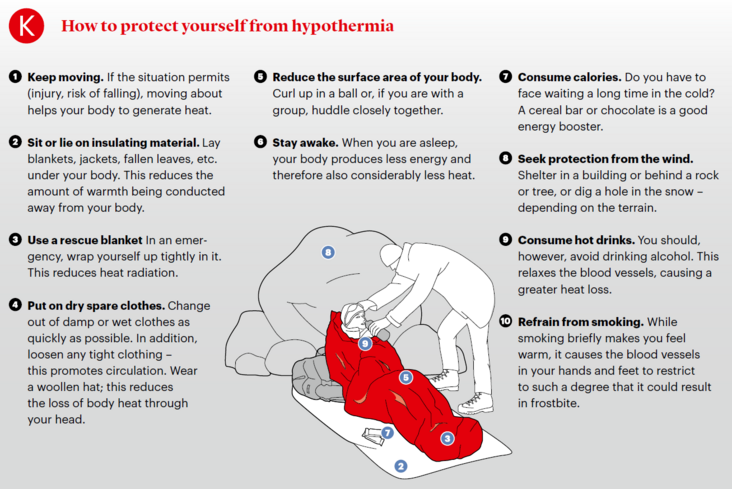When a person is injured or sick, the human body is especially sensitive to the cold and overexposure can very quickly have serious consequences. But how can we best protect ourselves against potentially life-threatening hypothermia? A decisive factor for effective prevention is being aware of how and in which situations hypothermia can occur and how our bodies react to the cold.
When the body loses heat
Our bodies constantly release heat to the outside environment via the skin and by exhaling. Hypothermia occurs when over a prolonged period of time the body loses heat faster than it can produce it. This happens mainly through radiation, conduction or convection. Radiation refers to the natural radiation of heat over the surface of the body. Conduction plays a role above all when sitting or lying on cold ground. With convection – the transport of heat through the air – imagine that the body is always surrounded by a relatively stable layer of warm air. If this layer is blown away by the wind, we also peak of the “wind chill factor”, which intensifies with increasing wind speeds.
The body switches to energysaving mode
Our normal body temperature is around 37 degrees Celsius. If this temperature threatens to drop, the body attempts on the one hand to minimise heat loss and on the other, to generate warmth. In order to educe the loss of heat, the blood vessels in the arms and legs constrict. This helps to keep the warm blood deeper inside the body where the vital organs are located. Our body generates heat by causing the muscles to shiver. These two effects of the cold are unpleasant, but in themselves are not dangerous. The secondary effects play a far more critical role: the high calorie requirement, the increased rate at which the heart needs to pump, and the blood’s ability to coagulate, which diminishes as the body temperature drops.
Hypothermia poses a serious risk particularly following an accident in the mountains – but also in the lowlands and, depending on the circumstances, even in the summer, too.
This knowledge about how our body reacts to the cold and which conditions lead to hypothermia also forms the basis of our 10 guidelines on preventing overexposure to the elements. Depending on the situation and the available equipment, it will not always be possible to follow all the advice. But maybe Rega’s tips will also give you some ideas for useful additions to your personal equipment.
Rega’s measures to combat the cold
Not only you yourself can help to minimise the effects of exposure to the cold by taking the right precautions. Rega also does much to alleviate the problems associated with hypothermia and to improve the body heat balance of its patients. All of its rescue helicopters are equipped with a series of useful aids.
For example, wrapping the patient in a bubble wrap blanket can prevent loss of the remaining body heat. This metal-coated air-cushion foil is often used in combination with a thermal blanket to additionally actively warm the patient. Another item in the Rega crews’ standard equipment is the Buddy Lite system, a portable IV fluid warmer that heats medical fluids or blood to body temperature. This gives patients the full benefit of the warmth supplied to the body by an infusion.However, the rule of thumb is: the best mission is always the one that can be averted. Careful planning and good equipment help to prevent accidents. If you nevertheless find yourself in need of medical assistance, do not wait too long to raise the alarm – especially in the cold months of the year. The cold can be a dangerous adversary.
For the forthcoming winter season, we wish you all the very best and accident-free fun in the snow.

